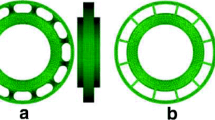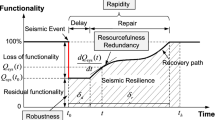Abstract
High-rise intake towers in high-intensity seismic areas are prone to structural safety problems under vibration. Therefore, effective and low-cost anti-seismic engineering measures must be designed for protection. An intake tower in northwest China was considered the research object, and its natural vibration characteristics and dynamic response were first analyzed using the mode decomposition response spectrum method based on a three-dimensional finite element model. The non-dominated sorting genetic algorithm-II (NSGA-II) was adopted to optimize the anti-seismic scheme combination by comprehensively considering the dynamic tower response and variable project cost. Finally, the rationality of the original intake tower antiseismic design scheme was evaluated according to the obtained optimal solution set, and recommendations for improvement were proposed. The method adopted in this study may provide significant references for designing anti-seismic measures for high-rise structures such as intake towers located in high-intensity earthquake areas.
Similar content being viewed by others
References
Zhang H Y, Li T C, Li Z K. Modeling in SolidWorks and analysis of temperature and thermal stress during construction of intake tower. Water Science and Engineering, 2009, 2(1): 95–102
Gong C L, Liu H, Zhang J. Study on dynamic properties of the intake tower with finite element method. Applied Mechanics & Materials, 2014, 501–504: 1888–1891
Wang Y, Lin Z T, Song C, Dong B Y. Seismic analysis of a water release integrated structure part I: Response spectrum analysis of intake tower. Applied Mechanics and Materials, 2014, 470: 938–941
Yan Y Z, Xiong C X, Wen X H, Li W H. Structure seismic analysis on intake tower of spillway tunnel. Advanced Materials Research, 2015, 1065–1069: 1427–1432
Alembagheri M. Earthquake response of solitary slender freestanding intake towers. Soil Dynamics and Earthquake Engineering, 2016, 90: 1–14
Zhang H Y, Zhang L J. Tuned mass damper system of high-rise intake towers optimized by improved harmony search algorithm. Engineering Structures, 2017, 138: 270–282
Bartoli G, Betti M, Galano L, Zini G. Numerical insights on the seismic risk of confined masonry towers. Engineering Structures, 2019, 180: 713–727
Zou X K, Chan C M. An optimal resizing technique for seismic drift design of concrete buildings subjected to response spectrum and time history loadings. Computers & Structures, 2005, 83(19): 1689–1704
Ftima M, Léger P. Seismic stability of cracked concrete dams using rigid block models. Computers & Structures, 2006, 84(28): 1802–1814
Gorai S, Mait D. Seismic response of concrete gravity dams under near field and far field ground motions. Engineering Structures, 2019, 196: 109292
Aldemir A. Prediction equation for the fundamental vibration period of concrete gravity dams with impounded water. Earthquake Spectra, 2021, 37(3): 1710–1725
GB 51247-2018. Standard for Seismic Design of Hydraulic Structures. Beijing: China Planning Press, 2018 (in Chinese)
Zhang Y, Li S Y, Xia K, Guo J J, He G J, Li M. Seismic study on backfill height of tower-back for high-rise intake tower structure. Water Resources and Hydropower Engineering, 2018, 49(11): 62–67 (in Chinese)
Yang G, Li S Y, Li L, Xiao Y, Zhang Z X, Yang Y. Effect of backfill height on seismic performance of high intake tower. Journal of Water Resources & Water Engineering, 2019, 30: 6 (in Chinese)
Zhang W J, Lu W B, Chen M, Yan P, Zhou C B. Analysis of consolidation grouting effect of rock mass based on comparison of wave velocity before and after grouting. Chinese Journal of Rock Mechanics & Engineering, 2012, 31(3): 469–478 (in Chinese)
Ang H, Lee J. Cost optimal design of R/C buildings. Reliability Engineering & System Safety, 2001, 73(3): 233–238
Esteva L, Díaz-Löpez O, García-Pérez J. Life-cycle optimization in the establishment of performance-acceptance parameters for seismic design. Structural Safety, 2002, 24: 187–204
Zheng P, Hobbs B, Koonce J. Optimizing multiple dam removals under multiple objectives: Linking tributary habitat and the Lake Erie ecosystem. Water Resources Research, 2009, 45(12): 1699–1702
Lozano M, Ramos J, Serra L. Cost optimization of the design of CHCP (combined heat, cooling and power) systems under legal constraints. Energy, 2010, 35(2): 794–805
Zhong D H, Li Z, Wu B P, Hu W, Lü P. Time-quality-cost tradeoff optimization of rockfill dam construction based on pareto solution. Journal of Tianjin University (Science and Technology), 2016, 49(10): 1001–1007
Bu K Z, Zhao Y, Zheng X C. Optimization design for foundation pit above metro tunnel based on NSGA2 genetic algorithm. Journal of Railway Science and Engineering, 2021, 18(2): 459–467 (in Chinese)
Zhang W B, Shi D D, Shen Z Z, Wang X H, Gan L, Shao W, Tang P, Zhang H W, Yu S Y. Effect of calcium leaching on the fracture properties of concrete. Construction & Building Materials, 2023, 365: 130018
Zhang W B, Shi D D, Shen Z Z, Shao W, Gan L, Yuan Y, Tang P, Zhao S, Chen Y S. Reduction of the calcium leaching effect on the physical and mechanical properties of concrete by adding chopped basalt fibers. Construction & Building Materials, 2023, 365: 130080
Chao Z M, Dang Y B, Pan Y, Wang F Y, Wang M, Zhang J, Yang C X. Prediction of the shale gas permeability: A data mining approach. Geomechanics for Energy and the Environment, 2023, 33: 100435
Chang L, Chang F. Multi-objective evolutionary algorithm for operating parallel reservoir system. Journal of Hydrology, 2009, 377(1–2): 12–20
Zare O, Saghafian B, Shamsai A, Nazif S. Multi-objective optimization using evolutionary algorithms for qualitative and quantitative control of urban runoff. Hydrology and Earth System Sciences Discussions, 2012, 9: 777–817
Wang S P, Zhao D M, Yuan J Z, Li H J, Gao Y. Application of NSGA-II algorithm for fault diagnosis in power system. Electric Power Systems Research, 2019, 175: 105893
Ghasemi H, Rafiee R, Zhuang X, Muthu J, Rabczuk T. Uncertainties propagation in metamodel-based probabilistic optimization of CNT/polymer composite structure using stochastic multi-scale modeling. Computational Materials Science, 2014, 85: 295–305
Ghasemi H, Brighenti R, Zhuang X, Muthu J, Rabczuk T. Optimal fiber content and distribution in fiber-reinforced solids using a reliability and NURBS based sequential optimization approach. Structural and Multidisciplinary Optimization, 2015, 51(1): 99–112
GB 18306-2015. Seismic Ground Motion Parameters Zonation Map of China. Beijing: China Earthquake Administration, 2015 (in Chinese)
SL 744-2016. Specification for Load Design of Hydraulic Structures. Beijing: China Water Power Press, 2016 (in Chinese)
Goyal A, Chopra A K. Hydrodynamic and foundation interaction effects in dynamics of intake towers: Earthquake responses. Journal of Structural Engineering, 1989, 115(6): 1386–1395
Goyal A, Chopra A K. Earthquake analysis of intake-outlet towers including tower-water-foundation-soil interaction. Earthquake Engineering & Structural Dynamics, 1989, 18(3): 325–344
Miranda E, Bertero V V. Evaluation of strength reduction factors for earthquake-resistant design. Earthquake Spectra, 1994, 10(2): 357–379
Deb K. Multi-objective genetic algorithms: Problem difficulties and construction of test problems. Evolutionary Computation, 1999, 7(3): 205–230
Ye C J, Huang M X. Multi-objective optimal power flow considering transient stability based on parallel NSGA-II. IEEE Transactions on Power Systems, 2015, 30(2): 857–866
Liu D, Huang Q, Yang Y Y, Liu D F, Wei X T. Bi-objective algorithm based on NSGA-II framework to optimize reservoirs operation. Journal of Hydrology, 2020, 585: 124830
Acknowledgements
This study was supported by the National Natural Science Foundation of the China/Yalong River Joint Fund Project (No. U1765205).
Author information
Authors and Affiliations
Corresponding author
Ethics declarations
Conflict of Interest The authors declare that they have no conflict of interest.
Rights and permissions
About this article
Cite this article
Yu, J., Shen, Z., Huang, Z. et al. Optimization design of anti-seismic engineering measures for intake tower based on non-dominated sorting genetic algorithm-II. Front. Struct. Civ. Eng. 17, 1428–1441 (2023). https://doi.org/10.1007/s11709-023-0998-2
Received:
Accepted:
Published:
Issue Date:
DOI: https://doi.org/10.1007/s11709-023-0998-2




